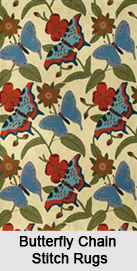 Chain stitch and crewel is one of the well-known handicrafts from Kashmir where a precise kind of embroidery is done with a pointed hook. Because of the high quality of embroidery done on wall hangings and rugs, Kashmiri crewelwork is in great demand all over the world. Chain stitch, be it in wool, silk or cotton, is done by hook rather than any needle. The hook is referred to as ari, and quality for quality, hook work covers a much larger area than needle work in the same amount of time. All the embroidery is executed on white cotton fabric, pre-shrunk by the manufacturers. The intrinsic worth of each piece lies in the size of the stitches and the yarn used.
Chain stitch and crewel is one of the well-known handicrafts from Kashmir where a precise kind of embroidery is done with a pointed hook. Because of the high quality of embroidery done on wall hangings and rugs, Kashmiri crewelwork is in great demand all over the world. Chain stitch, be it in wool, silk or cotton, is done by hook rather than any needle. The hook is referred to as ari, and quality for quality, hook work covers a much larger area than needle work in the same amount of time. All the embroidery is executed on white cotton fabric, pre-shrunk by the manufacturers. The intrinsic worth of each piece lies in the size of the stitches and the yarn used.
History of Chain Stitch and Crewel Furnishings of Kashmir
Crewel got its name from wool which is the thread being used for the crewel embroidery. This technique has very rich history dating back to approximately 1st Century BC. The art got its recognition and acknowledgment only in 16th and 17th century. Later on many different embroidery styles emerged and many of them found their place in India and abroad but the esteem of Crewel and chain stitch didn"t fade at all. In earlier times it was done only with wool and the fabric used was linen but later on many other yarns and fabrics were involved in the crewel embroidery.
Description of Chain Stitch and Crewel Furnishings of Kashmir
The chain stitch and crewel furnishing has expanded its reach from just small fabric embroidery to the large textile rolls used for furnishing. This crewel fabric is typically accessible in the 25 meters and 29 meters textile rolls and the width of this fabric may be 52" or 54". The price of the fabric is decided based on the amount of embroidery or the thickness of the embroidery.
Tiny stitches are used to cover the entire area-the figures or motifs are worked in striking colors; the background in a single color, made up of a series of coin sized concentric circles which impart dynamism and a sense of movement to a design. The background fabric should not be visible through the stitches. Crewel is basically similar to chain stitch. It is also Chain stitch done on White background, but here the motifs, mainly stylish flowers, do not cover the entire surface, and the background is not embroidered upon. Wool is almost invariably used in Crewelwork and color ways are not as elaborate as in Chain stitch. They make excellent household furnishings being hand or machine washable.



















